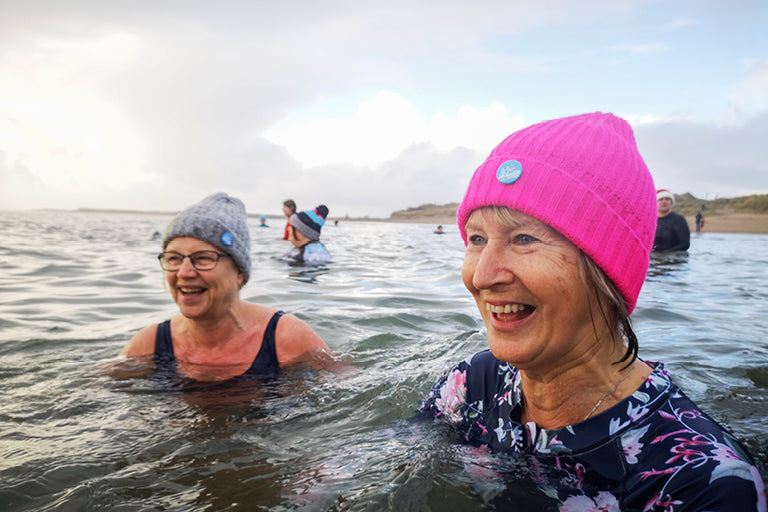Could now be the time to dip your toe into cold water swimming to help ease your menopause symptoms?
Cold-water swimming, sometimes known as wild water or open water swimming, is done (as its name suggests) outdoors in lakes, lochs, ponds, pools, rivers, lidos or the sea and has become hugely popular in the last few years. It is something that gained even more momentum during the lockdowns when public swimming baths were closed (so much so that in 2020 the UK Outdoor Swimming Society was forced to take down its map of designated swimming hotspots such was the overwhelming demand). What has also emerged out of this fitness and well-being trend are the number of women coming out to say how it has soothed and reduced their menopause symptoms. With this article, we explore how and why…
The health benefits of cold-water swimming
It is fair to say those who regularly go cold water swimming are quite evangelical about its stress-relieving, endorphin-creating, immune-boosting benefits, and there is research to show how it can help both mental and physical health.[1] While there is no strict definition of what constitutes ‘cold water’ it is generally taken to mean low temperatures of between 12-16°C[2] that result in a range of physiological stress responses when we plunge ourselves into it (and as experts from The Outdoor Swimming Society explain wild swimmers in the UK are almost always out in cold or cool temperatures as the temperature rarely warms to above 20°C).[3]
Evidence into precisely how it can reduce menopause symptoms is patchy, but it is becoming an emerging area of research – not least because there is a wealth of overwhelmingly positive anecdotal evidence from women revealing how it has helped them. Here are just some of the benefits that women report:
Reducing stress and anxiety. Wild/cold water swimming is not only a valuable form of exercise, but it is also often a very sociable activity (as women increasingly form swimming clubs and communities)[4] and both of these factors have documented benefits on mental health.[5],[6] The British Medical Journal has published a study showing how cold-water swimming can reduce depression and done regularly could potentially even help people come off antidepressant medication.[7] The health benefits of being in nature and the soothing effects of water are also well documented when it comes to improved mental health and many women describe feeling a sense of release and detachment when they are immersed in the waves. When menopause can throw up all manner of stresses, getting away from them all by taking a short open swim can not only make you more chilled but it can also help you to feel positively euphoric (see below). Anecdotally, many women report these mood boosting effects last for a few days after they have been swimming.
Buoying you up. Becoming part of a community of wild swimmers can help you to form new friendships and feel supported by a like-minded community of women. Many who are part of a swimming group also say that within it they feel less inhibited and self-conscious about what they look like and the whole experience is pretty much just geared toward having fun. During menopause when many women are feeling particularly vulnerable about their appearance and the fact that their body may be changing and not quite feel like their own this can have a hugely positive effect on their safe esteem.
Boosting immunity. Wild water swimming is also linked to a reduction in inflammation in the body which is known to help maintain healthy immunity. A study from Finland shows taking a cold shower for 15, 30 or 60 seconds reduced the amount of self-reported illness.[8] Another study carried out by Czech scientists (on men) shows that regular cold-water swimming (three times a week for an hour over six weeks in the study) appeared to show an improvement in immunity.[9] It is thought it does this because as you plunge yourself into ice cold water your body goes into a state of shock and in response, your immune system produces more white blood cells and chemicals called cytokines, which help boost the body’s ability to fight off harmful bacteria and viruses. White blood cells are also part of the immune system which help your body fight off infection.
Relieving joint pain and bone ache. These are some of the most commonly cited symptoms from perimenopausal and menopausal women and there is plenty of evidence to show how exercise (including yoga) can improve them. When it comes to cold-water swimming physiologically speaking what happens when you plunge your body into ice cold water is that it produces a ‘cold shock’ or a ‘fight or flight’ response releasing stress hormones including norepinephrine and endorphins which have an analgesic effect, relieving inflammation and muscle and joint pain. Swimming is also a safe weight-bearing exercise so you are not putting any undue impact or stress on your joints and doing it regularly can also stimulate your circulation, reduce muscle stiffness and increase flexibility.
Clarity of thought. Many women say that after the initial stages of ‘cold shock’ they experience increased clarity of mind and a reduction in brain fog. Others report feeling ‘more alive’ or more like their old selves after a bracing swim.
Burns calories. Recent research (carried out on men) suggests swimming outdoors (and in the winter) burns more calories than just regular swimming in your local heated pool. Calories seem to be burned at a faster rate when we are immersed in chilly water as our body then must work much harder to stay warm forcing us to burn more calories as we attempt to warm up. In conjunction with a healthy balanced diet open swimming could help you to lose weight and dealing with weight gain is consistently mentioned as a negative symptom of menopause for many women. According to the British Swimming School, you can expect to burn around 408 calories doing an hour of wild swimming (up to 476 calories if you are doing backstroke)[10] – that is the equivalent of more than half a chocolate orange.[11] For more information on how to avoid menopausal weight gain read Exercises for menopause weight gain
Reduces hot flushes and night sweats. Unsurprisingly, going into cold water can have a significant effect on your core body temperature. Even when you are out of the water your body’s temperature can continue to drop for anything up to 20-40 minutes- something known as the ‘afterdrop’. There is not enough evidence as yet to show that cooling your body temperature from the outside during wild swimming can reduce menopausal vasomotor symptoms like hot flushes and night sweats but anecdotally many women who are regular open water swimmers report a reduction in flushes and sweats.
Improves circulation and skin. Extreme cold can boost circulation and blood flow – forcing blood to the surface of the skin and in the process making your complexion look clearer and healthier.[12] Being immersed in cold water may also help reduce some inflammatory skin conditions like rosacea and the relaxing benefits of swimming can minimise stress-induced flare-ups in conditions like acne, eczema and psoriasis and skin itching – something many menopausal women complain about.
Produces post-swim euphoria. The heady mix of exercise and exposure to cold water triggers the release of dopamine, the body’s feel-good chemicals and this coupled with the buzz and freedom felt when wild water swimming all contributes to the fabled ‘high’ following a bracing swim. It is this that keeps almost all wild swimmers pushing through the initial cold shock and going back for more and more. When so many women going through menopause report feeling down, lost and struggle with aches and pains you can quite see why open swimming might provide a huge therapeutic boost – both physically and psychologically.
How to plan your cold-water swim
Before diving in to try wild swimming, read our tips on what to consider when planning your cold-water session:
Understand the risks. While immersing yourself in cold water can offer all sorts of therapeutic benefits it also comes with some risks particularly if you are an inexperienced swimmer. Take a look at safety advice and tips by The Royal National Lifeboat Institute (RNLI) to understand the risks of cold-water swimming in the UK.[13] The issue of pollution and sewage in the water is also something to factor into your swim so to check the water quality in your local sea or river download the free app from Surfers Against Sewage.[14] This gives information on over 390 beaches across England, Scotland and Wales and alerts you when sewage overflows discharge untreated sewage into the water or pollution incidents. It also details tide times, nearby facilities and lifeguard services.
Beware of red flags. Check the weather conditions before heading out into the coast (go to metoffice.gov.uk) and don’t go in the water if the red flags are up. This means it is not safe to swim.
Join a cold-water swimming club. If you prefer to swim with a group the Outdoor Swimming Society has compiled a list of wild swim groups in the UK.[15] The Bluetits Chill Swimmers – a group that came together through a mutual love of outdoor swimming and now boasts around 100,000 ‘Bluetits’ worldwide – also provide a helpful list of where you can find your nearest group.[16] There are many Facebook groups that have been set up to encourage more of us to get into wild swimming including Open Water Swimming UK,[17] Outdoor Swimming Society[18] and Wild Swimming UK.[19] Alternatively, just look up ‘cold water swimming clubs near me’ online for your nearest one.
Tips to help you during and after your swim:
How long should you stay safely in the water? It is generally accepted that a good safe rule of thumb when wild swimming is to stay in the water for one minute for one degree of water temperature – so, for example, if the water is 7°C you should stay in safely for seven minutes. This figure has now come under scrutiny, however, from experts at The Outdoor Swimming Society[20] who suggest how long you immerse yourself in the water for is more dependent on your size and weight. They also point out your tolerance can be affected by your health generally – so if you are stressed, tired, hungover this is likely to affect your resilience and how long you feel able to stay in the water. They also suggest some people are just better equipped at dealing with cold temperatures – particularly if they work outdoors, live in cold houses, and regularly exercise outside. They warn that you shouldn’t try to get competitive and/or bogged down with all the one minute per degree stuff and suggest you just do whatever feels right for you or as they put it ‘go gently, have fun, drop the macho-minute-per-degree nonsense and do it for you’.
Acclimatise yourself. It is important to acclimatise yourself to the bracing – some might say ‘shocking’ – temperatures of the water. Start slowly with maybe a minute or two twice a week and build up to more. Taking short sharp cold showers at home can also help you to build up to cold water dips. Some people suggest splashing cold water from the sea/river/pond/lido (wherever you are swimming) onto your face for around 15 seconds before you step in fully. This can help your body get used to the temperature, so it is not such a severe shock. When you do submerge yourself underwater take a minute to settle your breathing first rather than starting to swim immediately – just float or sit or kneel for 60 seconds. The Royal National Lifeboat Institute also suggest you wear a floatation device to keep you seen and safe.[21]
Have a swim buddy. Don’t head out into the open water on your own. If you are not part of a swimming group or don’t have anyone to go in the water with you, at least take someone to stay on dry land to remind you to come out and/or let you know how long you have been in.
Dress for it. You can invest in a neoprene (a type of synthetic rubber that is waterproof and has good insulating properties) swimming costume and/or wetsuit plus a swimming cap and possibly neoprene gloves and socks. Some wild swimming regulars, however, point out that a wetsuit can be difficult to get in and out of and in the winter, it can be a pain to get off in a hurry, whereas with a costume you can whip it off quickly and begin the process of warming up. Others also say wearing a costume as opposed to a wetsuit also helps them to feel more of the sensation of the water against their skin – making it more of an immersive and relaxing experience. To prepare for coming out of the water, take flip flops and leave them at the water’s edge and have an item of warm clothing like a thick towelling robe or large hoodie ready to throw on asap.
Warm up quickly. When you get out of the water the key is to dress and get warm as soon as you can. Take off your costume or wetsuit, towel yourself dry and wrap yourself in lots of layers. Many women keep their swimming cap on but add either a woolly hat on top or pull the hood of their hoodie up to retain more heat. Drinking warm tea or coffee will also help – so take a flask with you if there is nowhere nearby to buy a hot drink.
Kit list for cold-water swimming: |
| 1. Swimsuit |
| 2. Neoprene gloves |
| 3. Wet shoes |
| 4. Wetsuit (optional) |
| 5. Towel or changing robe |
| 6. Warm clothing layers |
| 7. Woolly hat and gloves |
| 8. Hot drink and snack |
| 9. Trug or bag to keep everything dry while you swim |
What are the alternatives to cold water swimming?
If you don’t live near any open water or can’t swim you can still enjoy some cold-water health benefits. Splashing your face with ice cold water as a final rinse after cleansing or taking an endorphin-boosting cold shower can help. Extreme athlete and motivational speaker Wim Hof who is famous for his ability to withstand very low temperatures regularly extols the benefits of cold showers for their exhilarating and therapeutic effects. He suggests trying a 20 second cold shower at the end of your usual one and then gradually building to a minute or two as your tolerance increases. Even if you are cold swimming on a regular basis, taking a cold shower at home can help keep you in the zone and reaping the health benefits.
Sources & references:
[1] https://pubmed.ncbi.nlm.nih.gov/33276648/
[2] https://www.outdoorswimmingsociety.com/cold-water-feels-temperature-guide/
[3] https://www.outdoorswimmingsociety.com/will-i-get-cold/
[4] https://www.bbc.co.uk/news/uk-wales-47159652
[5] https://www.waldenu.edu/online-bachelors-programs/bs-in-psychology/resource/five-mental-benefits-of-exercise
[6] https://www.mercycare.org/bhs/employee-assistance-program/eapforemployers/resources/health-benefits-of-social-interaction/#:~:text=Benefits%20of%20Socialization%3A,let%20them%20confide%20in%20you
[7] https://casereports.bmj.com/content/2018/bcr-2018-225007.abstract
[8] https://www.ncbi.nlm.nih.gov/pmc/articles/PMC5025014/
[9] https://pubmed.ncbi.nlm.nih.gov/8925815/
[10] https://britishswimschool.com/seattle/the-burn-how-many-calories-do-you-burn-swimming/#:~:text=Swimming%20ocean%2C%20river%2C%20lake%20408,Swimming%20backstroke%20476%20calories
[11] https://www.dietsandcalories.com/2011/09/calories-in-popular-chocolate-bars.html
[12]https://www.scotsman.com/arts-and-culture/what-are-health-benefits-open-water-swimming-1455636
[13] https://rnli.org/safety/choose-your-activity/open-water-swimming
[14] https://www.sas.org.uk/safer-seas-service/
[15] https://www.outdoorswimmingsociety.com/uk-wild-swimming-groups/
[16] https://thebluetits.co/pages/join-our-social-swim-community
[17] https://www.facebook.com/groups/OWSUK/
[18] https://en-gb.facebook.com/groups/outdoorswimmingsociety/?mibextid=6NoCDW
[19] https://www.facebook.com/groups/328578523990527/?mibextid=6NoCDW
[20] https://www.outdoorswimmingsociety.com/the-1-minute-per-degree-myth/
[21] https://rnli.org/safety/know-the-risks/cold-water-shock



